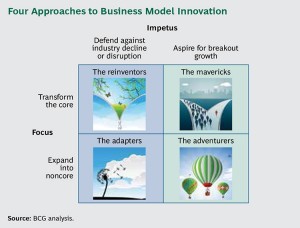Driving Growth with Business Model Innovation by Zhenya Lindgardt and Margaret Ayers October 08, 2014
Today, with increased marketplace volatility and the rising diversity of attractive customer segments, business models age faster than ever before—making business model innovation an important strategy for driving value-creating growth. It can be deployed to both defend and disrupt: a powerful response to declining competitiveness and a decisive means to seize new opportunities.
But executing business model innovation—the process of changing both the value that is promised to customers and how it is delivered to tap into new profit sources—is certainly more complex than traditional product or service innovation. It’s hardly surprising then that although 94 percent of the 1,500 senior executives surveyed in the 2014 installment of The Boston Consulting Group’s annual research on the most innovative companies reported that their companies had engaged in business model innovation to some degree, only 27 percent said their organizations were actively pursuing it. This is despite the fact that the complexity of the large-scale change effort involved makes it difficult for rivals to imitate, which affords successful innovators with both a longer head start and a more durable competitive advantage.
Companies hoping to drive growth through business model innovation face a number of critical questions: How broad should the scope of the effort be? What is the appropriate level of risk to take? Is it a onetime exercise, or does it call for an ongoing capability? How can a company discern which new business model is the most attractive? And what differentiates those companies able to transform their business models from those that might run a pilot but fail to fundamentally change the company’s trajectory?
To answer those questions, it is important to realize that not all efforts toward business model innovation are alike. Understanding four distinct approaches can help executives make effective choices in designing the path to growth.
Four Approaches to Business Model Innovation
To understand which business model innovation approach fits best for any individual company, it is critical to understand both impetus and focus. Impetus: Is the company defending against an external threat, such as commoditization, new regulation, or an economic downturn—or is it proactively disrupting the status quo? Focus: What is the most attractive area of opportunity—does it reside in the core business or in adjacent businesses or markets?
These two factors define a matrix of four approaches to business model innovation. (See the exhibit below.) Within each of the four approaches, companies will employ different tactics to successfully rebuild their models and make different choices.
- The reinventor approach is deployed in light of a fundamental industry challenge, such as commoditization or new regulation, in which a business model is deteriorating slowly and growth prospects are uncertain. In this situation, the company must reinvent its customer-value proposition and realign its operations to profitably deliver on the new superior offering.
- The adapter approach is used when the current core business, even if reinvented, is unlikely to combat fundamental disruption. Adapters explore adjacent businesses or markets, in some cases exiting their core business entirely. Adapters must build an innovation engine to persistently drive experimentation to find a successful “new core” space with the right business model.
- The maverick approach deploys business model innovation to scale up a potentially more successful core business. Mavericks—which can be either startups or insurgent established companies—employ their core advantage to revolutionize their industry and set new standards. This requires an ability to continually evolve the competitive edge or advantage of the business to drive growth.
- The adventurer approach aggressively expands the footprint of a business by exploring or venturing into new or adjacent territories. This approach requires an understanding of the company’s competitive advantage and placing careful bets on novel applications of that advantage in order to succeed in new markets.
